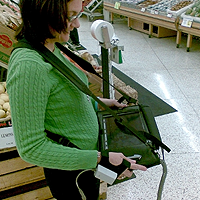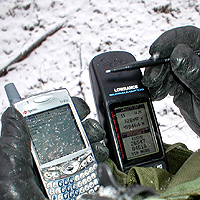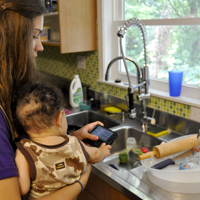 Over the years, the reaction to my job title, “mobile interaction designer,” has migrated from blank stares to significant interest in this suddenly mainstream technology. Still, only about half the time do people have any idea what that title means. And if they do, they almost always assume my job is to design mobile phones or apps for them.
Over the years, the reaction to my job title, “mobile interaction designer,” has migrated from blank stares to significant interest in this suddenly mainstream technology. Still, only about half the time do people have any idea what that title means. And if they do, they almost always assume my job is to design mobile phones or apps for them.
Occasionally, someone asks if we also design games for the Nintendo DS, or make maps for GPS navigation, or do work for some other sort of device. Has the definition of mo- bile changed? This is a list of the types of things we looked at to find and validate these patterns:
- Mobile smartphones
- Mobile feature phones
- Mobile network access points (aircards)
- Mobile Internet Devices (MIDs) • Tablets • eReaders
- Media players
- Image viewers and digital picture frames
- Portable game systems
- Remote controls
- Handheld navigation devices (see Figure P-5)
- Portable scanners
- Cameras and other capture devices
- Printers, scanners, copiers, and mopiers (multifunction devices or MFDs) • Kiosks
- Wearable computers
- Telematics, and vehicle-mounted devices
- Industrial automation
- Portable surveying, measuring, and metering equipment
The preceding list is not exhaustive. And although the items in the list share many charac- teristics, many are not particularly mobile. Kiosks are, by definition, bolted to the ground, for example. And no one much thinks of a camera as being similar to a phone.
So our first answer is that mobile is not a useful word, and that this book addresses a lot of these devices. Their design can be informed by the mobile patterns in this book and else- where. The ubiquity of mobile devices also may mean that employing these as universal patterns is a good thing, as users may require less training when using interfaces to which they are accustomed. If you design cameras or printers, you should be paying attention to the state of the art in mobile.
We didn’t come up with this answer out of the blue or just trust our instincts. Instead, years of work, discussion, writing, and arguing led to some principles of “what is mobile.”
We like to think of the evolution of mobile telephony as having occurred in four eras:
- Voice
- Paging and Text
- Pervasive network connectivity
- General computing devices
Yes, this leaves out a lot of interesting devices that are on the longer list shown earlier. The Game Boy and GPS receivers predate by several years what most of us would call mobile phones. But mobile telephony is what changed the world and ushered in all this, so it’s a good anchor point.
If you consider a current mobile phone as being a “fourth-era” device, you find that it has the following characteristics:
Small - It’s small enough to carry with you all the time, preferably in a pocket (see Figure P-1).
Portable - It’s battery-powered and otherwise independent of the world, so it doesn’t have to be plugged in or attended to regularly (see Figure P-2).
Connected - It’s wirelessly connected, not attached to the wall or connected only when the user makes special effort. Whenever possible, it is connected in multiple ways, to both voice and data networks (see Figure P-3).
Interactive - It’s inherently interactive. Unlike a watch, or even most MP3 players, which are lim- ited to display, playback, and a small subset of interactions, a mobile phone allows more undirected actions to be taken, such as text entry and keyword search.
Contextually-aware - It (or services it is attached to) uses its ability to understand the network to which it is attached, and its other sensors, to help the user get things done, and preemptively gather information (see Figure P-4).
 With this many facets, it’s easy to disregard any one of them and still feel the device meets your needs. By strapping an iPad to a wall and calling it a kiosk, all you’ve done is simply remove its “portable” feature, so it’s still a “mobile” device.
With this many facets, it’s easy to disregard any one of them and still feel the device meets your needs. By strapping an iPad to a wall and calling it a kiosk, all you’ve done is simply remove its “portable” feature, so it’s still a “mobile” device.
Consider the Wii or the Xbox Kinect instead. Though the display used on these devices is not at all portable, at its core it is aware of the user’s position, it changes with the type of input being used, and the entire interface has been designed to support interaction via a game controller, or via the user simply waving his arms at the screen. These meet the interactive criteria to be a “mobile” device.
Now take a Windows Tablet PC. It has pen and touch input, can be quite small and por- table, is networked, and has sensors. But we argue that it is not mobile. It’s not really connected, because it connects like a desktop, so you have to open dialog boxes and press buttons. It isn’t usefully interactive, because you cannot use it on the go, but rather have to stop to use it. It’s not contextually aware, because the GPS, or camera, or accelerometers don’t do much of anything by themselves.
What Type of Patterns We Will Cover
So, although this book does still focus on the mobile phone and, in particular, the smart- phone, similar interactions from kiosks to game stations to telematics are also considered. In some cases, we’ll even refer to these devices directly in the patterns.
 The patterns are guidelines for implementing interaction design on these devices. So they talk about page-level components such as scroll bars, display components such as pop ups, widgets such as buttons, and input methods such as keyboards.
The patterns are guidelines for implementing interaction design on these devices. So they talk about page-level components such as scroll bars, display components such as pop ups, widgets such as buttons, and input methods such as keyboards.
But they also talk about things such as the labels and lights for hardware keyboards. These are covered because you can influence them. You can fail to implement the keyboard correctly, and cause keyboard entry to fail. You can change scroll bar behavior, if there’s a special case for your application. Increasingly, as HTML5 technologies roll out, mobile websites can take advantage of interesting interactive features.
Also, you might be working on a device operating system—likely the GUI layer on top of an existing OS. There are many, many devices, and new classes are still emerging. Overlays have migrated down to the point that end users may change the basic behavior of their handsets. You may have to work in this space sooner than you think.
If not, you still need to understand why certain OS-level behaviors are standard, or should not be, so that you can make informed decisions about your design.
Next: What Is a Pattern?
Discuss & Add
Please do not change content above this like, as it's a perfect match with the printed book. Everything else you want to add goes down here.
Examples
If you want to add examples (and we occasionally do also) add them here.
Make a new section
Just like this. If, for example, you want to argue about the differences between, say, Tidwell's Vertical Stack, and our general concept of the List, then add a section to discuss. If we're successful, we'll get to make a new edition and will take all these discussions into account.


